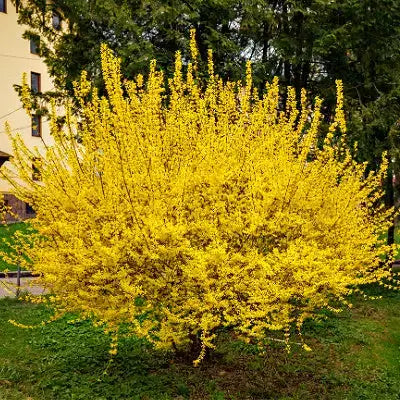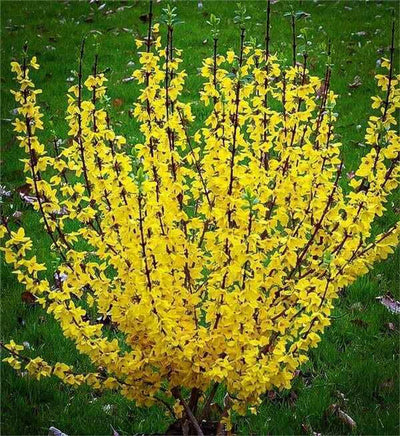Forsythia Shrubs: A Burst of Springtime Beauty
In the world of gardening and landscaping, few plants herald the arrival of spring quite like the forsythia shrub. With its vibrant yellow blooms that appear well before most other plants awaken from their winter slumber, the Forsythia holds a special place in the hearts of gardeners and nature enthusiasts alike. This hardy and versatile shrub offers an early burst of color, a fascinating history, various cultivars to choose from, and practical tips for successful cultivation.
Botanical Background and Characteristics of Forsythia Shrubs
Forsythia belongs to the Oleaceae family, commonly known as the Olive family. The genus Forsythia includes about 11 species, primarily native to East Asia. The most widely cultivated species is Forsythia x intermedia, a hybrid between F. suspensa and F. viridissima. Forsythia shrubs are deciduous, meaning they shed their leaves in the fall, and they are renowned for their striking yellow flowers that appear in early spring, often before their leaves emerge.
These shrubs typically grow to 6 to 10 feet (1.8 to 3 meters) with a similar spread, forming an upright and arching habit. The flowers emerge in clusters along the branches, creating a vibrant display that brightens the landscape. The leaves are simple, opposite, and serrated along the edges, with a medium to dark green color that provides a lovely backdrop for the showy flowers.
Historical Significance and Cultural Impact of Forsythia Shrubs
The forsythia shrub has a rich history that dates back centuries. It was named after Scottish botanist William Forsyth, who served as a head gardener to King George III. Forsyth is credited with introducing the plant to England in the 18th century. Since then, Forsythia has become a beloved harbinger of spring across many parts of the world.
In Japan and China, Forsythia is deeply ingrained in cultural traditions. In Japan, the forsythia flower is associated with the change of seasons and is celebrated during the Doll's Festival (Hina Matsuri), which takes place in early March. The forsythia flower is often linked to happiness and good fortune in China.
Varieties and Cultivars: Over the years, horticulturists and gardeners have developed numerous cultivars of Forsythia to suit different preferences and landscape needs. Some popular cultivars include:
- Forsythia x intermedia 'Lynwood Gold': This cultivar is well-known for its profuse and early bloom, producing bright yellow flowers more significant than the species.
- Forsythia x intermedia 'Spectabilis': Also known as the showy Forsythia, this cultivar features larger flowers and a slightly more compact growth habit.
- Forsythia 'Arnold Dwarf': As the name suggests, this cultivar is more compact, making it suitable for smaller gardens or container planting.
- Forsythia x intermedia 'Weekend': This cultivar blooms slightly later than others, extending Forsythia's blooming season. Its flowers are a paler shade of yellow.
- Forsythia suspensa: This species is characterized by its weeping habit, making it an excellent choice for cascading over walls or along slopes.
- Forsythia viridissima: This species is notable for its arching branches and bright yellow blooms, adding a touch of elegance to any landscape.
Cultivation and Care of Forsythia Shrubs
Forsythia shrubs are relatively simple to grow and care for, making them suitable for novice and experienced gardeners. Here are some tips for successful cultivation:
- Site Selection: Forsythias thrive in full sun to partial shade. Choose a location with well-draining soil to prevent soggy roots.
- Planting: Plant forsythias in the early spring or fall, allowing their roots to establish before the heat of summer or the cold of winter.
- Watering: While established forsythias are drought-tolerant, regular watering is essential during the establishment period. Water deeply and consistently, especially during dry spells.
- Pruning: Prune forsythia shrubs immediately after flowering, as they produce blooms on the previous year's growth. Regular pruning helps maintain their shape and encourages new growth.
- Fertilization: Apply a balanced, slow-release fertilizer in early spring to support healthy growth and flowering.
- Pest and Disease Control: Forsythias generally resist most pests and diseases. However, watch for aphids and scale insects, which can occasionally become problematic.
- Propagation: Forsythias can be propagated through hardwood cuttings taken in late fall or early winter. Rooting hormones can enhance the success rate.
Landscape Uses and Design Ideas: Forsythia shrubs have a range of landscape uses, making them versatile additions to gardens and outdoor spaces. Some design ideas include:
- Hedging: Forsythias can create vibrant flowering hedges, providing a natural and colorful boundary to your property.
- Mass Planting: Planting multiple forsythias together can create a stunning mass of yellow blooms that is particularly eye-catching in early spring.
- Accent Plant: Use a forsythia as a focal point in a landscape design, drawing attention with its brilliant yellow flowers.
- Foundation Planting: Forsythias can be strategically placed near the foundation of a house or other structures to add visual interest and curb appeal.
- Erosion Control: Varieties like Forsythia suspensa, with their cascading growth habit, can be planted on slopes to help prevent soil erosion.
Conclusion: Forsythia shrubs are undeniably a symbol of spring's arrival, infusing landscapes with their vibrant yellow blooms after the drabness of winter. With their rich history, numerous cultivars, and relatively easy cultivation requirements, forsythias are cherished by gardeners and all who appreciate nature's beauty. Whether used as a colorful hedge, a focal point in a garden, or a simple reminder that warmer days are ahead, forsythia shrubs have earned their place in parks worldwide.
Forsythia Planting Patterns: Maximizing Beauty and Benefits
Forsythia shrubs go beyond their visual appeal, offering a range of benefits that make them a valuable addition to any garden or landscape. From their aesthetic contributions to their environmental advantages, these vibrant shrubs bring much more than just early spring color. Here are some of the benefits that forsythia shrubs offer:
Early Burst of Color: One of the most apparent and delightful benefits of forsythia shrubs is their early burst of vibrant yellow flowers. In regions where winter can linger, these cheerful blooms serve as a joyful indicator that spring has arrived, lifting spirits and rejuvenating the landscape.
Landscape Interest: With arching branches, forsythia shrubs add dynamic interest to a garden, creating unique shapes and textures that stand out even when not in bloom. This architectural element contributes to the overall visual appeal of the garden throughout the year.
Wildlife Attraction: The bright flowers of forsythia shrubs attract early pollinators such as bees, providing them with an essential source of nectar after the scarcity of winter. This supports local ecosystems and promotes biodiversity in your garden.
Erosion Control: Certain varieties of Forsythia, such as Forsythia suspensa, have a cascading growth habit that makes them practical for slope erosion control. Their roots help stabilize the soil, reducing the risk of erosion caused by heavy rainfall.
Hedge and Privacy Screening: Forsythia shrubs can be planted close together to create dense walls that serve as natural screens, providing privacy and minimizing noise pollution. Their rapid growth rate allows them to form practical barriers relatively quickly.
Forsythia shrubs are admired for their bright yellow blooms that signal the start of spring. Forsythia shrubs bring radiant yellow blossoms that enhance formal gardens and informal outdoor spaces. Forsythia grows quickly, but gardeners can significantly improve their garden's appearance through careful planting methods and patterns. These planting methods help you position forsythia shrubs to achieve maximum aesthetic appeal and practical use.
Forsythia plants are frequently used to create boundary hedges in gardens. Planting these shrubs in a single row along a fence line or property boundary creates an attractive living fence during early spring and evolves into a dense green wall as the season progresses. To achieve a thick hedge that stands firm against intrusion, plant each shrub four to six feet apart from each other. The distance between plants ensures each shrub can expand appropriately while keeping the hedge visually consistent. Be sure to plan for the whole growth size of Forsythia to prevent noticeable openings in your hedge.
A staggered arrangement will create more visual drama within your landscape design. Begin by planting one row of shrubs and then make a staggered second row a few feet behind the first row so that plants from the second-row fit between those of the first row. The layered planting technique adds depth and movement to your landscape design while enhancing privacy when necessary. The staggered pattern maximizes Forsythia's arching branches, creating a dense and full appearance during flowering.
You can create interesting designs by positioning Forsythia as a central element in island beds and mixed borders. The bright yellow flowers of these plants draw attention, whether displayed alone or in small clusters. While arranging shrubs into clusters, aim for groups of three or five plants, which allows each shrub sufficient space for its branches to spread gracefully. Enhance the visual appeal by planting spring-flowering bulbs like daffodils or tulips around the Forsythia. After its yellow flowers disappear, the Forsythia maintains its bed structure through its thick green leaves.
Select a planting site with six hours of sunlight daily for the most vibrant spring display. While Forsythia can adapt to different soil types, it reaches its full potential in well-draining soil that retains consistent moisture. Planting sites can be prepared by loosening soil structure and mixing it with organic matter or compost to create a nutrient-rich environment for root growth. Create a planting hole extending twice the root ball's width while maintaining depth. Use a mixture of soil and compost to fill the hole after positioning the Forsythia inside and gently press it down to eliminate air pockets. Pour water over the plant until it fully saturates, and then apply a mulch layer to help maintain soil moisture and control weed growth.
While maintenance requirements are low, they remain necessary to maintain a healthy and adequately formed plant. Prune Forsythia right after the blooms fade. Eliminate dead or damaged branches, then selectively remove or shorten some of the oldest branches near the base to stimulate new growth. This method maintains the plant's natural arching shape and prevents excess growth. When using Forsythia as a hedge, you can trim the shrubs to achieve a formal appearance, yet this might diminish the brightness of their springtime blooms.
Selecting an appropriate planting layout, like a neat row or a decorative focal cluster, along with proper maintenance, will help you experience the stunning display of Forsythia's vibrant flowers annually. These strategies will transform your forsythia shrubs into the main attractions of your early spring landscape.


